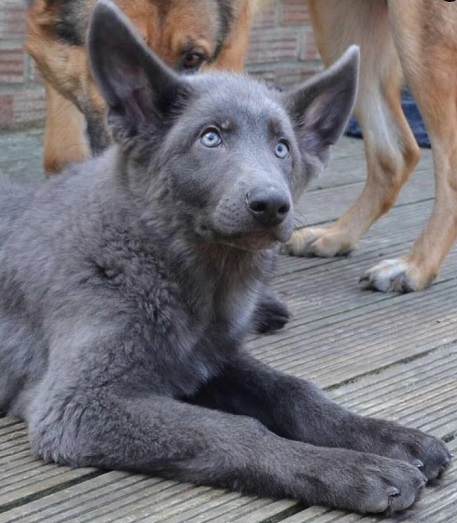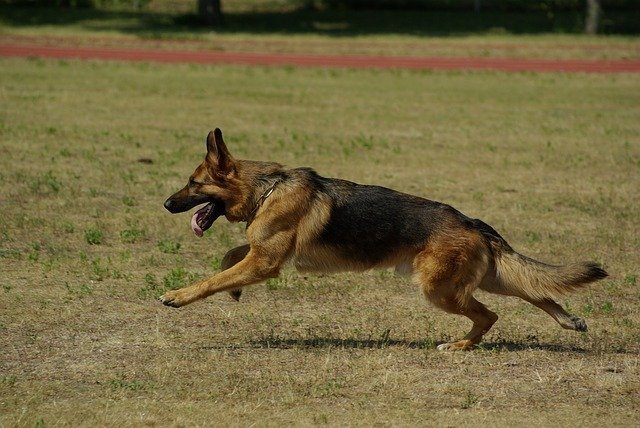Thinking about getting a German Shepherd puppy? Be aware the German shepherd Puppies change their color as they grow.
Causes for coat color change in German Shepherd puppies could be genetics, natural coat molting, diseases, growth, diet, and stress. Even in adults, coat color can change. Reasons include diet, hormones, diseases, and aging.
German Shepherd Coat Color Genetics
You might wonder how some of the many colors come in German shepherd. The truth is that dog genetics works in a similar fashion to human genetics.
When it comes to deciding the color of a coat, eyes, and nose, genes make the decision. But, certain conditions need to be met in order for a German Shepherd to display a coat color.
Types of Genes
Each parent will donate a set of genes to the German Shepherd puppies. Of these genes some are dominant and some are recessive.
Dominant
Genes that are dominant can be represented on the coat even if one parent passes this gene on. For example the black and tan coat.
Recessive
Genes that are recessive will only be represented on the coat if both parents pass this gene to the puppy. For example the blue coat color.
Apart from the genetics of ‘dominant’ and ‘recessive’ genes, there is another genetic explanation for the coat color change. This involves two pigment conditions, eumelanin, and pheomelanin. Let’s discuss what each of these conditions involves.
Eumelanin
Dogs with eumelanin usually almost display a black coat. But, the addition of other genes is what produces some of the rarer coat colors. Isabella, liver, and blue are a few colors that are shown when the eumelanin pigment is diluted.
Read about 15 Amazing Blue German Shepherd Facts in case you want one.
Eumelanin doesn’t just decide the base color of the dog’s coat. It also dictates the eye and nose color of a German Shepherd puppy.
Pheomelanin
Pheomelanin always forms a red coat color. But, the color red is broad and can mean a range of colors such as rust-colored browns, pale golds, and even yellows. These colors can appear when other genes dilate the pheomelanin pigments.
Pheomelanin, unlike eumelanin, does not make any changes to the color of the eyes and nose of a German Shepherd puppy. It exclusively caters to the coat color alone and does not influence any other characteristics.
German Shepherd Puppy Coat Changing Timeline
The first few weeks after birth are the most important for a German Shepherd puppy. Their coat will take a maximum of 18 months (1.5 years) to completely stop changing for natural reasons.
If coats change beyond this time, it may not be a good sign! You should take this sign seriously and consult a vet immediately.
Birth to 2 Weeks Old
Most German Shepherd puppy litters are born with a solid coat color (black, grey, or white). Despite being born with a solid coat, German Shepherds will not stay this way for long!
Their appearance will change greatly in just a few weeks. Not just in terms of coat color but also the patterns and length of the coat. Even this early on, breeders can distinguish if the puppies will have a long or medium hair coat.
3 Weeks To 8 Weeks
After the 3 weeks mark, expect drastic changes to happen to the coat. This involves repeated lightening and darkening of the hair coat. This is quite a large change for puppies that are just becoming almost 6 weeks old.
Breeders even mention and explain that the coat of German Shepherd puppies can vary greatly from each other.
This is no fault and you will have to wait for adulthood to see their final coat. Within a litter, puppies can show very different appearances and may not look like siblings!
3 Months to 6 Months
During the 3 and 6-month intervals, colors will come through and intensify.
If your dog is a solid color with light shades, expect his true colors to become very visible during this time period. Tan, sable, brindle, and bi-color combinations will become darker during this time.
Another notable event in this time period is that the coat can shed off in gradual stages. German Shepherd breeders can expect some more color changes.
7 Months to 18 Months
It is at the 7-month mark that breeders decide the German Shepherd puppies can go to their forever homes. Most puppies by now have their permanent coats and colors will just intensify and get darker.
But, the chance of coats having a full makeover in terms of color should not be ruled out just yet.
19 Months Onwards
After this point in time, a German Shepherd will rarely show any changes in his coat color. He has transitioned from a puppy to an adult and his coat color is here to stay.
However, on some occasions, you may still see changes in the coat color. These changes are not desirable and could have a deeper meaning. You should consult your local vet to diagnose the reason for the coat color change this late.
Reasons for coat color change in a 24-month+ German Shepherd could be:
Poor diet
What a dog eats shows. Poor coat color and texture are signs of poor diet.
You could be feeding your dog many times yet he still has a dull coat that is changing color. The reason for this could be cheap dog food.
He must be lacking some vital nutrients in his diet. Diet amendment is essential to replenish his coat and restore the right colors.
Disease
Is your dog ill and suffering from a disease? If so this could be a cause of concern for coats changing color.
Vitiligo
Vitiligo is a condition in which the patches of hair begin to turn white. This is not a curable disease and can affect any dog breed. It may be hereditary or brought about by autoimmune conditions.
Cancer
This is a serious disease and does more than just affect a dog’s hormones and coat color. If diagnosed late, it is lethal! Regular vet visits will be crucial in catching this disease in time.
Notice something odd on your dog’s nose? Find out what are White Spots On A Dog’s Nose.
Hormonal Issues
When a dog is under stress, anxiety, or is pregnant, hormone levels are irregular. As a result, the coat will also be affected and show color and density differences.
Excessive Amount Of Time In Sunlight
Hard to believe but too much time in the sun can fade and affect your German Shepherd’s coat color.
If you want to avoid this, get your German Shepherd into the habit of resting in the shade. Also, limit activity when the sun is most intense.
Age
If your senior German Shepherd is changing his coat color, this could be a sign of aging. Black hair patches will start turning to a grey color and then eventually a white color. But the hair won’t be completely white!
Common Coat Colors
Take a look at the most commonly found German Shepherd coat colors. These will be easily available at all breeders and even shelters.
Black and Tan
The black and tan color combination is the most popular and widely found German Shepherd coat color. These German Shepherd puppies may be born black, but eventually, their hair lightens up and turns tan.
It is not compulsory for the light areas to be tan. These areas could easily be red, cream, or silver.
Black and Red
Just as the black and tan German Shepherd exists, black and red coat variants can also exist. Except the red may not be as deep red as you would expect. Instead, it could range from rust-like red to deep reddish browns.
This large catalog of reds can make for an appealing German Shepherd coat that will gain many admirers.
Bi-Color
Bicolor coats consist of two distinct colors in a single coat. The majority of the dog’s body is black or another dark color. Areas that are not black could be brown, grey, cream, etc. All in all, bi-color German Shepherd dogs are popular.
The American president J. F. Kennedy even had bicolor German Shepherds with him at the White House. Many people are becoming more and more open to this coat color.
Sable (Tricolor German Shepherds)
German Shepherd with a sable coat is originally born with a completely tan coat. Later on, the coat gradually lightens in some areas.
One or in most cases, two colors join in the tan coat. The resultant tricolor coat (sable) is very attractive and is gaining a lot of popularity for its unique look.
Gray
The gray coat of a German Shepherd appears to resemble that of a wolf. Coats of this type can have gray, silver, or a combination appearing on the saddle. These are common but not as common as the typical black and tan or red combinations.
Rare Coat Colors
When the name German Shepherd is spoken, two distinct colors come to mind, these are black and tan. But, a prospective dog owner might not know that this is one of many breed standard colors. Black and tan are just one of many standard coat colors.
The other AKC-approved German Shepherd coat colors might just shock you!
But apart from these, there are the rarer harder-to-find coat colors that are not yet approved by German Shepherd groups.

Blue
The blue color is one of the most uncommon and rare coats a German Shepherd can have. But, many dog associations such as the AKC consider this coat to be a flaw.
That being said, blue German Shepherds cannot enter dog shows and competitions.
Liver
Dogs that have the liver coat have a recessive gene that does not allow the color black to be expressed. As a result all areas that are meant to be black end up being brown instead. The dog then bears a coat that appears liver-colored.
Panda
The panda coat is not common and gets its name from its appearance. The coat is white with presence of black spots scattered around the coat.
White
While white is thought to be the first ancestral German Shepherd coat color, today it is considered a fault. In dog shows a white coat is a reason enough to get a German Shepherd disqualified completely.
Pale or Dilute
Another undesirable coat color quality that most dog shows do not accept is pale, dilute, and washed-out coat colors. This includes white and liver, and other coats that are predominately made from these colors.
FAQs
Most puppies will display their true coat color by the age of two years old. However, each dog is different and some will stop changing coat colors after a year. Some might still change color till the age of three years.
Most German Shepherd puppies are born with black or similarly solid coat color. As they grow up, their coat will lighten in areas where patches will appear.

